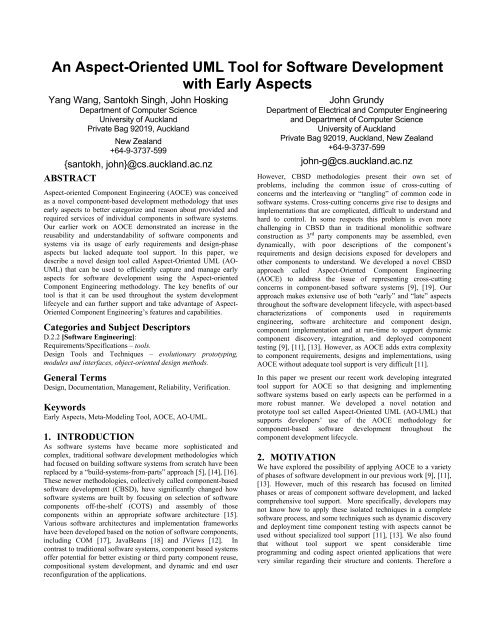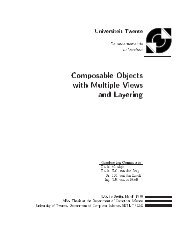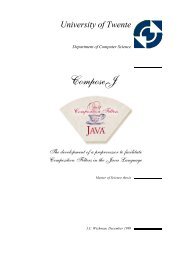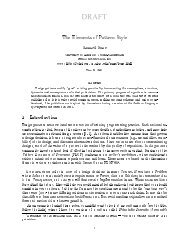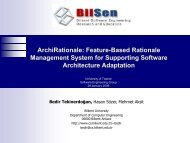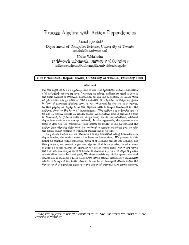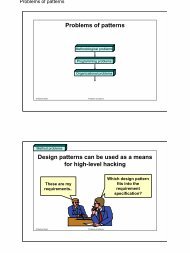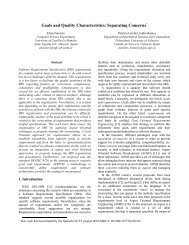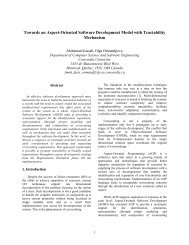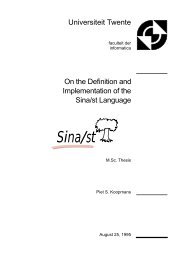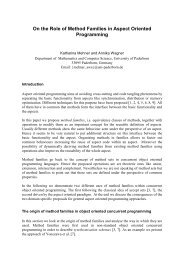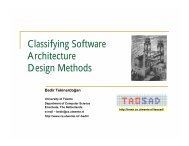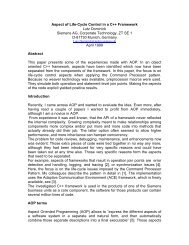An Aspect-Oriented UML Tool for Software Development with ... - trese
An Aspect-Oriented UML Tool for Software Development with ... - trese
An Aspect-Oriented UML Tool for Software Development with ... - trese
You also want an ePaper? Increase the reach of your titles
YUMPU automatically turns print PDFs into web optimized ePapers that Google loves.
<strong>An</strong> <strong>Aspect</strong>-<strong>Oriented</strong> <strong>UML</strong> <strong>Tool</strong> <strong>for</strong> <strong>Software</strong> <strong>Development</strong><br />
<strong>with</strong> Early <strong>Aspect</strong>s<br />
Yang Wang, Santokh Singh, John Hosking<br />
Department of Computer Science<br />
University of Auckland<br />
Private Bag 92019, Auckland<br />
New Zealand<br />
+64-9-3737-599<br />
{santokh, john}@cs.auckland.ac.nz<br />
ABSTRACT<br />
<strong>Aspect</strong>-oriented Component Engineering (AOCE) was conceived<br />
as a novel component-based development methodology that uses<br />
early aspects to better categorize and reason about provided and<br />
required services of individual components in software systems.<br />
Our earlier work on AOCE demonstrated an increase in the<br />
reusability and understandability of software components and<br />
systems via its usage of early requirements and design-phase<br />
aspects but lacked adequate tool support. In this paper, we<br />
describe a novel design tool called <strong>Aspect</strong>-<strong>Oriented</strong> <strong>UML</strong> (AO-<br />
<strong>UML</strong>) that can be used to efficiently capture and manage early<br />
aspects <strong>for</strong> software development using the <strong>Aspect</strong>-oriented<br />
Component Engineering methodology. The key benefits of our<br />
tool is that it can be used throughout the system development<br />
lifecycle and can further support and take advantage of <strong>Aspect</strong>-<br />
<strong>Oriented</strong> Component Engineering’s features and capabilities.<br />
Categories and Subject Descriptors<br />
D.2.2 [<strong>Software</strong> Engineering]:<br />
Requirements/Specifications – tools.<br />
Design <strong>Tool</strong>s and Techniques – evolutionary prototyping,<br />
modules and interfaces, object-oriented design methods.<br />
General Terms<br />
Design, Documentation, Management, Reliability, Verification.<br />
Keywords<br />
Early <strong>Aspect</strong>s, Meta-Modeling <strong>Tool</strong>, AOCE, AO-<strong>UML</strong>.<br />
1. INTRODUCTION<br />
As software systems have became more sophisticated and<br />
complex, traditional software development methodologies which<br />
had focused on building software systems from scratch have been<br />
replaced by a “build-systems-from-parts” approach [5], [14], [16].<br />
These newer methodologies, collectively called component-based<br />
software development (CBSD), have significantly changed how<br />
software systems are built by focusing on selection of software<br />
components off-the-shelf (COTS) and assembly of those<br />
components <strong>with</strong>in an appropriate software architecture [15].<br />
Various software architectures and implementation frameworks<br />
have been developed based on the notion of software components,<br />
including COM [17], JavaBeans [18] and JViews [12]. In<br />
contrast to traditional software systems, component based systems<br />
offer potential <strong>for</strong> better existing or third party component reuse,<br />
compositional system development, and dynamic and end user<br />
reconfiguration of the applications.<br />
John Grundy<br />
Department of Electrical and Computer Engineering<br />
and Department of Computer Science<br />
University of Auckland<br />
Private Bag 92019, Auckland, New Zealand<br />
+64-9-3737-599<br />
john-g@cs.auckland.ac.nz<br />
However, CBSD methodologies present their own set of<br />
problems, including the common issue of cross-cutting of<br />
concerns and the interleaving or “tangling” of common code in<br />
software systems. Cross-cutting concerns give rise to designs and<br />
implementations that are complicated, difficult to understand and<br />
hard to control. In some respects this problem is even more<br />
challenging in CBSD than in traditional monolithic software<br />
construction as 3 rd party components may be assembled, even<br />
dynamically, <strong>with</strong> poor descriptions of the component’s<br />
requirements and design decisions exposed <strong>for</strong> developers and<br />
other components to understand. We developed a novel CBSD<br />
approach called <strong>Aspect</strong>-<strong>Oriented</strong> Component Engineering<br />
(AOCE) to address the issue of representing cross-cutting<br />
concerns in component-based software systems [9], [19]. Our<br />
approach makes extensive use of both “early” and “late” aspects<br />
throughout the software development lifecycle, <strong>with</strong> aspect-based<br />
characterizations of components used in requirements<br />
engineering, software architecture and component design,<br />
component implementation and at run-time to support dynamic<br />
component discovery, integration, and deployed component<br />
testing [9], [11], [13]. However, as AOCE adds extra complexity<br />
to component requirements, designs and implementations, using<br />
AOCE <strong>with</strong>out adequate tool support is very difficult [11].<br />
In this paper we present our recent work developing integrated<br />
tool support <strong>for</strong> AOCE so that designing and implementing<br />
software systems based on early aspects can be per<strong>for</strong>med in a<br />
more robust manner. We developed a novel notation and<br />
prototype tool set called <strong>Aspect</strong>-<strong>Oriented</strong> <strong>UML</strong> (AO-<strong>UML</strong>) that<br />
supports developers’ use of the AOCE methodology <strong>for</strong><br />
component-based software development throughout the<br />
component development lifecycle.<br />
2. MOTIVATION<br />
We have explored the possibility of applying AOCE to a variety<br />
of phases of software development in our previous work [9], [11],<br />
[13]. However, much of this research has focused on limited<br />
phases or areas of component software development, and lacked<br />
comprehensive tool support. More specifically, developers may<br />
not know how to apply these isolated techniques in a complete<br />
software process, and some techniques such as dynamic discovery<br />
and deployment time component testing <strong>with</strong> aspects cannot be<br />
used <strong>with</strong>out specialized tool support [11], [13]. We also found<br />
that <strong>with</strong>out tool support we spent considerable time<br />
programming and coding aspect oriented applications that were<br />
very similar regarding their structure and contents. There<strong>for</strong>e a
tool to integrate our various AOCE techniques was urgently<br />
needed to provide an integrated development environment (IDE).<br />
In this paper, the terms of <strong>Software</strong> <strong>Development</strong> Methodology<br />
and <strong>Software</strong> Process Model are based on Boehm’s definitions [5]<br />
where he maintains a clear distinction between the two.<br />
Even though our previous research has evaluated our AOCE<br />
techniques in realistic scenarios, the evaluations have only<br />
concerned a specific development phase independent of other<br />
phases and its impact on the whole development life cycle. Thus<br />
our AO-<strong>UML</strong> IDE project is aimed at investigating the capability<br />
of the AOCE techniques to support whole lifecycle aspectoriented<br />
component engineering in an efficient manner.<br />
Furthermore, although we believe AOCE has strong potential <strong>for</strong><br />
improvement of component-based software engineering, it is only<br />
an abstract methodology <strong>with</strong>out proper tool support. For<br />
developers who wish to explore AOCE, our AO-<strong>UML</strong> tool<br />
provides a systemic and recipient way <strong>for</strong> them to learn about<br />
AOCE techniques and apply them in their own scenarios.<br />
3. EARLY ASPECTS AND AOCE<br />
<strong>Aspect</strong> oriented software development (AOSD) [1], [7] has<br />
become an important new approach to software engineering.<br />
AOSD addresses the problem of overlapping, horizontal crosscutting<br />
concerns across multiple classes (and components) that<br />
exist in traditional software development. The fundamental idea<br />
here is to use aspects to represent concerns that cut modules, and<br />
implement aspects at a programming level separately from the<br />
modules. This enables aspects to be easily managed and<br />
controlled since they are isolated from the modules, and once<br />
defined, modules can be reconfigured by weaving aspect code in.<br />
Up until the last few years, most work using aspects has been<br />
limited to the implementation phase of software development, i.e.<br />
finding cross-cutting concerns that implementation units have in<br />
common and factoring those out as aspects. Many current<br />
applications of aspects, such as in <strong>Aspect</strong>-<strong>Oriented</strong> Programming<br />
(AOP) [19],[22], mainly concentrate on the implementation phase<br />
of the life cycle. These aspects are actually code blocks that can<br />
specify different concerns in modules. However, much recent<br />
work has tried to generalize the concept and apply it to different<br />
phases of the life cycle. A new direction of AOSD is to identify<br />
and categorize aspects, called early aspects, in early phases of the<br />
life cycle, and convert them into programming level aspects <strong>for</strong><br />
modules in the implementation phase. Identifying aspects at an<br />
early stage helps to achieve separation of crosscutting concerns in<br />
the initial system analysis instead of deferring such decisions to<br />
later stages of design and code, hence avoiding costly redesigning<br />
and refactorings. Several approaches have been introduced to try<br />
to assist in the identification of early aspects <strong>for</strong> AOSD, these<br />
includes Theme [4], Early-AIM [22], and EA-Miner [20].<br />
However, most such techniques are still in initial stages of<br />
research. Our whole of lifecycle AOCE methodology [9], [11] is<br />
one such technique. AOCE uses a concept of different cross<br />
cutting systemic capabilities (clearly defined early aspects such as<br />
persistency, security, user interface, transaction, configuration,<br />
collaboration, resource utilisation etc.) which are identified in the<br />
early phases of the System’s <strong>Development</strong> Life Cycle (SDLC).<br />
These aspects are used to categorize and reason about provided<br />
and required services of individual candidate components in a<br />
software system, whether these may be existing or to-be-<br />
developed components. AOCE supports the identification,<br />
description and reasoning about the component’s high-level<br />
functional and non-functional requirements grouped by different<br />
early aspects, <strong>with</strong> “aspect details” and “detail properties”<br />
providing an ontology and constraint language to express<br />
constraints on the provided and required relationship between<br />
components and component compositions. AOCE component<br />
requirements are refined into design-level software component<br />
services implementing these aspects but which are also<br />
characterized by more detailed design and implementation-level<br />
aspects, tracable back to the requirements-level aspects.<br />
Components are implemented using aspect characterizations to<br />
support dynamic component description, discovery, adaptation,<br />
reconfiguration and deployment-time testing [11]. Using AOCE,<br />
components can be automatically indexed by their early aspects,<br />
and users can <strong>for</strong>mulate high-level queries about the component’s<br />
capabilities. Moreover, some pre-defined properties of early<br />
aspects in AOCE provide validation functions <strong>for</strong> sensible<br />
configurations of any retrieved components [11].<br />
In the past we have redesigned and redeveloped some complex<br />
traditionally implemented component-based software systems<br />
using AOCE <strong>for</strong> proof of concept purposes [12] using manual<br />
application of AOCE techniques (i.e. <strong>with</strong>out tool support).<br />
These results were very encouraging and show that re-engineering<br />
using AOCE can produce significantly better characterized<br />
component requirements and more easily reused and reconfigured<br />
components. The early aspect in<strong>for</strong>mation provides advantages<br />
during component requirements analysis and design, such as rich<br />
multiple perspectives <strong>for</strong> components, better structuring of<br />
components and design, better dynamic configuration and decoupled<br />
component interaction, and run-time access to detailed<br />
component knowledge [12], [20]. Having proven the concept our<br />
aim now is to develop usable, comprehensive and novel tools to<br />
support the whole AOCE software development process. The AO-<br />
<strong>UML</strong> tool presented here is the first of these and is novel in its<br />
comprehensive support <strong>for</strong> aspects across the SLDC.<br />
4. AO-<strong>UML</strong><br />
Our prototype AO-<strong>UML</strong> tool has the capability to support several<br />
perspectives <strong>for</strong> software development using AOCE. These<br />
include a component-based system’s functional requirements,<br />
architectural designs and detailed component specifications and<br />
characteristics. <strong>An</strong> exemplar application developed using AO-<br />
<strong>UML</strong> is used to illustrate the tool’s capabilities. We implemented<br />
AO-<strong>UML</strong> <strong>with</strong> the Pounamu meta-CASE tool which was used to<br />
specify and generate the AO-<strong>UML</strong> IDE.<br />
The Pounamu [27] meta-CASE tool supports specification and<br />
generation of multiple view visual tools. The tool permits rapid<br />
specification of visual notational elements, underlying tool<br />
in<strong>for</strong>mation model requirements, visual editors, the relationship<br />
between notational and model elements, and behavioral<br />
components. Pounamu can generate visual modeling tools<br />
automatically and the tools used <strong>for</strong> modeling immediately.<br />
4.1 FUNCTIONAL REQUIREMENTS<br />
The SDLC literature introduces and defines various phase models<br />
[1], [3], [9], [15]. These models, however, while using different<br />
terminology, have very similar phases in terms of the activities<br />
defined in the phases. We have identified six core phases that<br />
define an SDLC based on the descriptions in these papers; these
six phases are listed in Table 1 together <strong>with</strong> the overall<br />
requirements <strong>for</strong> those phases. Table 1 also lists the functional<br />
requirements of AO-<strong>UML</strong> <strong>for</strong> each of the SDLC phases. For<br />
example, in the <strong>Software</strong> Requirements <strong>An</strong>alysis phase shown, we<br />
list out the services that the system should provide as aggregate<br />
early aspects and this identification of aspects is done very early<br />
in the life cycle.<br />
Phase Requirements Functions provided by<br />
AO-<strong>UML</strong><br />
Planning System engineering Initializing the project<br />
and modeling, which in AO-<strong>UML</strong> and the<br />
involves in setting up AOCE component<br />
the required resources<br />
such as hardware,<br />
people and software.<br />
database*.<br />
<strong>Software</strong><br />
<strong>An</strong>alyzing the<br />
Listing out services that<br />
Requirement requirements of the the system should<br />
<strong>An</strong>alysis<br />
software system. provide as aggregate<br />
early aspects.<br />
System <strong>An</strong>alysis Defining overall Invoking components<br />
and Design software structure. that might be reused<br />
from the AOCE<br />
component database.<br />
Implementation Translating the design<br />
into a plat<strong>for</strong>mreadable<br />
<strong>for</strong>mat such as<br />
Java, C# or PHP.<br />
Testing After the code is<br />
generated, developers<br />
should start testing the<br />
code in a planned<br />
manner.<br />
Maintenance <strong>Software</strong> will definitely<br />
be updated <strong>for</strong> some<br />
reason, e.g. <strong>for</strong> bug<br />
fixing or functional<br />
enhancement after it is<br />
Defining components<br />
and their aspects<br />
in<strong>for</strong>mation.<br />
<strong>Aspect</strong>s mapping across<br />
components.<br />
Deploying components<br />
to <strong>UML</strong> design.<br />
Generating code <strong>for</strong><br />
various plat<strong>for</strong>ms.<br />
(Current version only<br />
supports Java)<br />
Dynamic Validation<br />
Agents to support<br />
deployment of<br />
component testing.[11]<br />
Storing and querying<br />
components from<br />
AOCE database<br />
through AO-XML<br />
standard. [13]<br />
delivered to customer. Reverse engineering<br />
<strong>with</strong> aspect<br />
in<strong>for</strong>mation.<br />
*AOCE component database: A component database which supports the storage and<br />
query of aspect in<strong>for</strong>mation of the component.<br />
Table 1: Functional Requirements of AO-<strong>UML</strong><br />
Even though we used the system development life cycle (SDLC)<br />
<strong>for</strong> the software process model (SPM) to introduce the functions<br />
of AO-<strong>UML</strong>, these functions can in fact be applied to any SPM to<br />
support development using Early <strong>Aspect</strong>s. One of these models is<br />
our eXtreme AOCE [22] which extends the features of both<br />
AOCE and eXtreme Programming (XP) to support cross-cutting<br />
concerns of the components <strong>with</strong> Agile techniques. Instead of<br />
developing the software system as a whole in SDLC, eXtreme<br />
AOCE tends to slice the system into small pieces containing<br />
aspect in<strong>for</strong>mation, and work on developing them separately.<br />
Through this method, the development team can handle any<br />
change of requirements more rapid and easily, at the same time<br />
achieve a high level of productivity. Also, eXtreme AOCE drives<br />
the team to produce high quality reusable aspect-oriented<br />
software components based on AOCE concepts. For employing<br />
eXtreme AOCE as the SPM in AO-<strong>UML</strong>, each small piece of new<br />
program that needs to be developed is treated as an independent<br />
mini-project that is then merged <strong>with</strong> the remainder of the<br />
program once it has been tested. There<strong>for</strong>e, developers can do the<br />
requirements analysis, aspect identification and component design<br />
<strong>for</strong> each small piece as if they are working on independent<br />
projects <strong>with</strong>out disrupting the rest of the system that is already<br />
developed. As such, though the AO-<strong>UML</strong> is specially built <strong>for</strong><br />
software development using AOCE, it is versatile and can also be<br />
used to fully support other AOCE related techniques like eXtreme<br />
AOCE because of the tool’s ability to enable the design and<br />
construction of high quality aspect-oriented components and<br />
address issues concerning Early <strong>Aspect</strong>s during the development<br />
of the software.<br />
4.2 Architecture of AO-<strong>UML</strong><br />
The architecture of AO-<strong>UML</strong>, shown in Figure 1, consists of three<br />
main parts, the Graphical User Interface (GUI), a repository and<br />
an implementation factory. The GUI of AO-<strong>UML</strong> is composed of<br />
three view types, which can be switched between: the component,<br />
aspect and <strong>UML</strong> views. Each view type has its own visual<br />
symbols and semantics <strong>for</strong> describing the design in multiple<br />
perspectives. The aspect view manages in<strong>for</strong>mation concerning<br />
component aspects and their mapping (the mapping is presented<br />
as aggregate aspects). The component view is used to gather<br />
in<strong>for</strong>mation about components including their child classes,<br />
aspects and the mapping between methods and aspects. The<br />
<strong>UML</strong> view co-operates <strong>with</strong> the component view. It allows users<br />
to import the classes defined in the component views and use<br />
additional notations provided by the <strong>UML</strong> view to complete the<br />
<strong>UML</strong> class diagram <strong>for</strong> implementation. Even though these three<br />
view types have their own concepts and definition, some of their<br />
visual symbols such as classes and aspects share the same<br />
meaning and properties. The AO-<strong>UML</strong> thus provides a way of<br />
sharing these kinds of concerns and symbols across different view<br />
types and to synchronize the entities relating to these.<br />
Figure 1: The overall architectural design of AO-<strong>UML</strong><br />
<strong>An</strong> aspect-oriented component repository is used by AO-<strong>UML</strong><br />
users to store and share in<strong>for</strong>mation concerning all AO-
components developed so far. This supports fast search and<br />
retrieval of these components using aspect-enhanced queries. AO-<br />
<strong>UML</strong> can also be used to visualize the components as notations<br />
on its views and allow users to reuse them in their designs and<br />
analysis. In order to communicate <strong>with</strong> the repository, a schema<br />
is required <strong>for</strong> both sides to interpret and understand the<br />
conversation. AO-XML [23] is a novel schema which we<br />
developed to define the grammar <strong>for</strong> exchanging aspectual<br />
in<strong>for</strong>mation. This schema defines an XML [26] document type<br />
which stores in<strong>for</strong>mation related to the components and their<br />
aspects in a well-structured way.<br />
The final part of the architectural design is an implementation<br />
factory. This provides tool support <strong>for</strong> the implementation phase<br />
such as transferring the design into a plat<strong>for</strong>m-readable <strong>for</strong>m,<br />
implementing reverse engineering and exporting XMI files.<br />
Based on the <strong>UML</strong> design diagrams drawn, AO-<strong>UML</strong> can be used<br />
to generate code scripts <strong>for</strong> various plat<strong>for</strong>ms to minimize the<br />
developer’s ef<strong>for</strong>t in writing code. The current AO-<strong>UML</strong> version<br />
generates Java scripts. AO-<strong>UML</strong> can also support reverse<br />
engineering to allow recovery of a design <strong>with</strong> aspect in<strong>for</strong>mation<br />
from code scripts. Since XMI is a well-known and widely used<br />
standard <strong>for</strong> exchanging programming data (typically <strong>UML</strong> data),<br />
AO-<strong>UML</strong> provides functions <strong>for</strong> generating XMI documents.<br />
4.3 AO-<strong>UML</strong> NOTATION<br />
Figure 3 describes the main visual elements of the component<br />
view type. These include the component, class, aspect, connector<br />
and event flow symbols. In a software system developed using<br />
AOCE, all system components are aspect oriented by categorizing<br />
their operations <strong>with</strong> early aspects.<br />
Visual Symbol Explanation<br />
A software component is a reusable piece of software<br />
which has some certain functions, and can be<br />
integrated <strong>with</strong> other components.<br />
A class is a reference type that encapsulates data and<br />
defines its behaviors using methods, properties, events<br />
etc. A class is one of the elements of a component.<br />
<strong>Aspect</strong>s are system capabilities that can be cross-cut<br />
between components to identify, describe and reason<br />
about the system’s high level functional and nonfunctional<br />
requirements.<br />
A connector is used to connect related entities to<br />
expose their relations e.g. the component this class<br />
belongs to.<br />
The event flow describes what a component does to<br />
another component in a particular case. It is used in<br />
the component use case diagram at the early stage to<br />
reason about the components at a very abstract level.<br />
Figure 3: Sample of modeling capabilities in component views.<br />
<strong>An</strong> AO-component may consist of several classes which are also<br />
aspect oriented, meaning that each and every method in a class of<br />
this type of component is also categorized as belonging to aspects<br />
that either provide services to other methods or require services<br />
from other methods across components. These services are<br />
defined as aspect details which are categorized into particular<br />
aspect types [9] (e.g. Persistency, User Interface type of aspects).<br />
<strong>An</strong> AO-component can be composed of one or more aspect types,<br />
and in our AO-<strong>UML</strong> tool, each aspect type can be depicted as<br />
having several “provided” (prefixed “+”) or “required” (prefixed<br />
“-“) aspect details. The purpose of the component view is to allow<br />
users to design the components and their classes <strong>with</strong> aspect<br />
in<strong>for</strong>mation.<br />
Figure 4 shows the main visual elements of the aspect view and<br />
their explanations. Unlike the component view which<br />
concentrates on individual components and their constructs, the<br />
aspect view focuses on components’ aspects and the system’s<br />
aggregate aspects. This view type shows the details of all kinds<br />
of aspects and the aspect mapping in<strong>for</strong>mation across components<br />
and is vital <strong>for</strong> understanding the aspects’ effects and impact<br />
across the components and system.<br />
Visual Symbol Explanation<br />
<strong>An</strong> aggregate aspect is a set of services provided by the<br />
software system, these service are from several<br />
provided or required aspects of the same aspect type of<br />
different components<br />
<strong>Aspect</strong>s in this view are imported from the component<br />
view, so they correspond to the same element but<br />
shown on different representation layers. <strong>Aspect</strong>s in<br />
this view are automatically synchronized <strong>with</strong> the<br />
aspects in the component view.<br />
A connector is used to connect related entities to expose<br />
their relations such as what aspects this aggregate<br />
aspect consists of.<br />
Figure 4: Sample of modeling capabilities in aspect views.<br />
The visual elements used in the <strong>UML</strong> view type are shown in<br />
Figure 5. The <strong>UML</strong> view is used to show details of how the<br />
classes are constructed and related to each other, and hence has<br />
<strong>UML</strong> specific symbols. The current prototype implements all the<br />
essential notational elements of <strong>UML</strong> class diagrams.<br />
4.4 AN EXEMPLAR APPLICATION<br />
This section provides an example to demonstrate the usage of the<br />
AO-<strong>UML</strong> through the whole SDLC. The scenario is a simple<br />
online banking system called “Simple Bank”. To develop this<br />
software system we shall assume the following requirements:<br />
• The system must be developed using Java (Java Servlets <strong>for</strong><br />
the website).<br />
• The bank’s customers are able to login to the system<br />
through the website.<br />
• Customers can view their account balances and deposit or<br />
<strong>with</strong>draw money through the website.<br />
• All accounts in<strong>for</strong>mation is stored in a database.<br />
In the Planning phase, developers receive the project from their<br />
customers and after the resources and working environments in
the AO-<strong>UML</strong> are set up, developers start gathering requirements.<br />
This proceeds into the analysis of the requirements phase, where<br />
requirements are identified as the functional services of the<br />
system, and are stated as aggregate aspects in AOCE.<br />
Visual Symbol Explanation<br />
<strong>An</strong> interface in <strong>UML</strong> is represented by a rectangle <strong>with</strong> a<br />
sign of “interface”.<br />
A class in <strong>UML</strong> is represented by a rectangle <strong>with</strong> a sign<br />
of “class; this entity can be imported from the component<br />
view.<br />
<strong>An</strong> aggregation represents “whole/part” or “has-a”<br />
relationships between classes.<br />
<strong>An</strong> association in <strong>UML</strong> indicates the relationship between<br />
an object of one type <strong>with</strong> an object of another type.<br />
A generalization represents a relationship in which one<br />
class is of a more specialized version of the other.<br />
A dependency is a relationship in which an object of one<br />
type must rely on an object of another type.<br />
Figure 5: Basic modeling capabilities of the <strong>UML</strong> view type<br />
Figure 6 shows the aggregate aspects and their aspect details as<br />
listed in AO-<strong>UML</strong>’s aspect view. In this figure, the tool also lists<br />
out the aspect details (services) of the system. In the following<br />
phase, developers will commence analysing the gathered<br />
requirements to design the components. To design and structure<br />
the components, AO-<strong>UML</strong> provides various icons and functions<br />
in its component view to help developers design the system step<br />
by step.<br />
Figure 6: Aggregate aspects of the “Simple Bank” example.<br />
A component use case diagram <strong>for</strong> the “Simple Bank” system is<br />
shown in Figure 7. These types of diagrams are very useful <strong>for</strong><br />
developers to think and reason about all the possible components<br />
required and assign tasks to them at an early stage of the<br />
development process to increase efficiency.<br />
Figure 7: A component use case diagram <strong>for</strong> SimpleBank.<br />
Figure 8: The component diagram of AccountManager.<br />
Be<strong>for</strong>e:<br />
After:<br />
Figure 9: The aspect diagram <strong>for</strong> the persistency aspect<br />
be<strong>for</strong>e and after being mapped.<br />
The components can then be specifically designed and structured<br />
one by one in AO-<strong>UML</strong>’s component view. Figure 8 shows the
constructs of the AccountManager component from our exemplar<br />
application. This component consists of two classes, Account and<br />
AccountManager. The aspects and aspect details of the classes are<br />
also depicted. For example the AccountManager class has two<br />
types of aspects,. Collaborative Work and Persistency. Each of<br />
these aspect types are further shown to contain several aspect<br />
details, including “provided +” or “required -” (i.e. this aspect<br />
provides or requires this service) attributes.<br />
After the components’ design is completed, their aspects can be<br />
imported into the aspect view where the required and provided<br />
aspect details can be matched together. The first row in the table<br />
illustrated in Figure 9 shows the aspect diagram <strong>for</strong> the<br />
persistency aspects from the various different components of our<br />
exemplar system. <strong>Aspect</strong>s can be mapped using AO-<strong>UML</strong>’s<br />
“<strong>Aspect</strong> Mapper” to match particular aggregate aspect details.<br />
Through this approach, we can obtain all the aggregate aspect<br />
details mapped <strong>with</strong> their corresponding provided and required<br />
aspects. The lower diagram in figure 9 shows the persistency<br />
aspect-diagram that was produced after mapping the component’s<br />
aspects. In this, we see that the “store data” service required by<br />
the Account Manager persistency aspect is provided by the<br />
DatabaseManager Persistency aspect “store data” service. A<br />
further mapping could be used to match “retrieve data” services.<br />
A snippet of the AO-XML document generated from the sample<br />
project is shown in Figure 10. To export the in<strong>for</strong>mation of the<br />
components and aspects that has been designed, users can use<br />
AO-<strong>UML</strong>’s export function to generate the AO-XML [14] shown.<br />
This document is very useful and can be read by the AO-<strong>UML</strong><br />
tool to regenerate the design diagrams in the tool.<br />
<br />
<br />
<br />
<br />
<br />
<br />
…………<br />
<br />
<br />
<br />
<br />
<br />
<br />
<br />
<br />
<br />
<br />
<br />
<br />
…………………..<br />
<br />
<br />
<br />
<br />
<br />
<br />
<br />
<br />
<br />
<br />
<br />
…………………<br />
<br />
<br />
Figure 10: Example of the AO-XML “Simple Bank” project.<br />
AO-<strong>UML</strong>’s <strong>UML</strong> view provides icons and connectors <strong>for</strong><br />
developers to draw <strong>UML</strong> class diagrams <strong>with</strong> pre-populated<br />
classes from the component view. <strong>An</strong> example of the <strong>UML</strong> class<br />
diagram of the “Simple Bank” application is shown in Figure 11.<br />
During this phase, developers are working on the static/structural<br />
design of the software. Classes in this view need to be completed<br />
<strong>with</strong> all the necessary parameters and connected to each other<br />
using <strong>UML</strong> connectors. Java skeleton code is generated by AO-<br />
<strong>UML</strong> after all the aspect-oriented <strong>UML</strong> class diagrams are<br />
completed. Full business logic etc. can be inserted into the<br />
skeleton code based on the specifications of the system being<br />
built. All code and component-interfaces are generated in objects<br />
constructed <strong>with</strong>in their respective components <strong>with</strong> their<br />
namespaces clearly defined to aid developers.<br />
Figure 11: A <strong>UML</strong> class diagram <strong>for</strong> “Simple Bank”<br />
<br />
<br />
<br />
<br />
Novosoft <strong>UML</strong> Library<br />
0.4.20<br />
…………<br />
<br />
AccountManager<br />
<br />
<br />
<br />
<br />
………….<br />
Figure 12: Portion of XMI document from the “SimpleBank”.<br />
In addition to system code generation, the AO-<strong>UML</strong> can also<br />
export this <strong>UML</strong> in<strong>for</strong>mation in the design diagrams as an XMI<br />
document, an example is shown in Figure 12. It is part of the<br />
AccountManager object from our example of the SimpleBank<br />
project <strong>with</strong> its major elements included in the figure. The tool<br />
can also be used to store, inspect and retrieve all XMI and AO-<br />
XML documents, designs, generated code and aspect-oriented<br />
components from its repository, as in [13]. Other software<br />
engineers may also use the AO-<strong>UML</strong> to locate these objects from<br />
the repository and may reuse any or all of them.<br />
5. DISCUSSION<br />
Developing the AO-<strong>UML</strong> tool and using it <strong>for</strong> software<br />
development based on AOCE techniques has given us valuable<br />
hands-on experience on the significance and application of AOCE<br />
and early aspects in real world scenarios. We have shown a<br />
sample application (an extension of “SimpleBank”) developed<br />
using AO-<strong>UML</strong>. While using AO-<strong>UML</strong> we have noted some<br />
features of the prototype tool which can be improved upon.<br />
Currently there is a lack of navigation support <strong>for</strong> the individual<br />
elements across views, e.g. <strong>for</strong> navigation involving aspects and<br />
classes. Users of the tool currently have to manually search<br />
through the diagrams to find related components. A search and<br />
indexing mechanism would mitigate the hidden dependencies that
otherwise result. Formatting of detailed in<strong>for</strong>mation as text inside<br />
the visual icon of the corresponding component has room <strong>for</strong><br />
improvement. For example, in figure 9 above, the string<br />
“+retrieve data ==> (-retrieve data@AccountManager)(+retrieve<br />
data@Database) () etc.” could be better rendered. In addition,<br />
capability to elide some of this detail is needed. Though AO<strong>UML</strong><br />
provides quite comprehensive functions to support AOCE<br />
development phases it still needs to be improved to provide<br />
services and functions in the requirements phase. Currently users<br />
identify their own aspects and design components manually in the<br />
tool, and this can be quite laborious and time consuming. One<br />
solution is to provide a comprehensive library that can be used to<br />
look-up, identify, reuse or store aspects and aspect details.<br />
<strong>An</strong>other possible improvement is to provide specific visual <strong>UML</strong><br />
icons and code generation <strong>for</strong> various target systems. More<br />
substantial future directions include the following:<br />
• Designing and developing a more comprehensive AOcomponent<br />
repository, possibly on top of a traditional<br />
component database <strong>with</strong> aspect-based indexing.<br />
• We are currently migrating Pounamu to the Eclipse IDE [9]<br />
in the <strong>for</strong>m of a new meta tool (Marama). This opens up the<br />
possibility of migrating AO-<strong>UML</strong> into Eclipse as well.<br />
Integration as an Eclipse plug-in will potentially permit us<br />
to integrate <strong>with</strong> Eclipse <strong>UML</strong> tools (offering improved<br />
<strong>UML</strong> support), code generators, and code views.<br />
• The current version of AO-<strong>UML</strong> lacks adequate tool<br />
support <strong>for</strong> the testing phase. We plan to re-develop<br />
validation agents that can automatically test the components<br />
<strong>with</strong> their non-functional constraints and properties [11].<br />
• Reverse engineering is another area that we are very<br />
interested in. One challenge here is how to recover<br />
aspectual in<strong>for</strong>mation from code scripts. In<strong>for</strong>mation of<br />
aspects and components can be retrieved from AO-<strong>UML</strong>’s<br />
component repository, so one solution may be to use an<br />
indexing and query framework to retrieve this in<strong>for</strong>mation.<br />
6. SUMMARY<br />
<strong>Aspect</strong> <strong>Oriented</strong> Component Engineering or AOCE is a<br />
methodology that uses early aspects to develop aspect-oriented<br />
software components. These components are the basic building<br />
blocks of our aspect-oriented software systems. We successfully<br />
designed and developed a novel tool called the <strong>Aspect</strong>-<strong>Oriented</strong><br />
<strong>UML</strong> (AO-<strong>UML</strong>) that can be used to efficiently capture and<br />
manage early aspects <strong>for</strong> software development using AOCE. We<br />
also showed how the AO-<strong>UML</strong> can be used throughout a system’s<br />
development life cycle based on capturing and using early aspects<br />
in aspect-oriented components.<br />
7. REFERENCES<br />
[1] Araujo, J., Baniassad, E., Clements, P., Moreira, A. and<br />
Tekinerdogan, B. Early <strong>Aspect</strong>s: The Current Landscape, Feb 2005.<br />
[2] Arthur, L. J. <strong>Software</strong> Evolution: The <strong>Software</strong> Maintenance<br />
Challenge. New York: Wiley & Sons (1988)<br />
[3] Bader, J., Edwards, J., Harris-Hones, C., & Hanna<strong>for</strong>d, D.<br />
Practical engineering of knowledge-based systems. In<strong>for</strong>mation and<br />
<strong>Software</strong> Technology (1988), 5, 266-277.<br />
[4] Baniassad, E. and Clarke, S. Theme: <strong>An</strong> approach <strong>for</strong> aspectoriented<br />
analysis and design. Proceeding of the 26 th International<br />
Conference on <strong>Software</strong> Engineering (ICSE’04) IEEE 2004.<br />
[5] Boehm, B. W. A spiral model of software development and<br />
enhancement. Computer, (1988) 21, 61-72.<br />
[6] Bosch, F. v. e., Ellis, J. R., Freeman, P., Johnson, L., McClure,<br />
C.L., Robinson, D., Scacchi, W., Scheff, B., Staa, A.v., Tripp, L.L..<br />
Evaluation of <strong>Software</strong> <strong>Development</strong> Life Cycle. <strong>Software</strong><br />
Engineering Notes (1982) Vol 7 no1, Page 45-59, ACM SIGSOFT<br />
[7] Chitchyan, R. and Rashid, A. Survey of <strong>Aspect</strong>-<strong>Oriented</strong> <strong>An</strong>alysis<br />
and Design Approach. AOSD-Europe (May 2005).<br />
[8] Connors, D. T. <strong>Software</strong> <strong>Development</strong> Methodologies and<br />
Traditional and Modern In<strong>for</strong>mation Systems. <strong>Software</strong> Engineering<br />
Notes (1992 ) Vol 17 no2, Page 43, ACM SIGSOFT<br />
[9] Eclipse.org, Eclipse Modeling Framework (EMF), at URL:<br />
http://www.eclipse.org/emf/<br />
[10] Grundy, J. Multi-perspective specification, design and<br />
implementation of software components using aspects.<br />
International Journal of <strong>Software</strong> Engineering and Knowledge<br />
Engineering (2000) vol.10, No. 6.<br />
[11] Grundy, J.C., Ding, G., and Hosking, J.G. Deployed <strong>Software</strong><br />
Component Testing using Dynamic Validation Agents, Journal of<br />
Systems and <strong>Software</strong>, vol. 74, no. 1, Jan 2005, Elsevier, pp. 5-14.<br />
[12] Grundy, J.C. and Hosking, J.G. Engineering plug-in software<br />
components to support collaborative work, <strong>Software</strong> – Practice and<br />
Experience, vol. 32, Wiley, pp. 983-1013, 2002.<br />
[13] Grundy, J.C. Storage and retrieval of <strong>Software</strong> Component using<br />
<strong>Aspect</strong>s. In Proc. Of the 2000 Australasian Computer Science<br />
Conference, Canberra, Australia (Jan 30-Feb 3 2000.<br />
[14] Henderson-Sellers, B.S. and Edwards, J.M. Object-<strong>Oriented</strong><br />
Systems Life Cycle. Communication of The ACM, (1990) Vol 35,<br />
No9, Page 142-159<br />
[15] Pour, G. Moving toward Component-Based <strong>Software</strong> <strong>Development</strong><br />
Approach. Technology of Object-<strong>Oriented</strong> Languages. TOOLS 27.<br />
Proceedings 22 - 25 Sept. 1998 Page(s): 296 – 300<br />
[16] Pour, G. Component-based software development approach: new<br />
opportunities and challenges. Technology of Object-<strong>Oriented</strong><br />
Languages., 3 - 7 Aug. 1998 Page(s): 376 – 383<br />
[17] Sessions, R, COM and DCOM: Microsoft’s vision <strong>for</strong> distributed<br />
objects, Wiley, 1998<br />
[18] O’Neil, J. and Schild, H. Java Beans Programming from the Group<br />
up, Osborne McGraw-Hill, 1998<br />
[19] Panas, T., <strong>An</strong>dersson, J. and Assmann, U. The editing aspect of<br />
aspects. In I. Hussain, editor, <strong>Software</strong> Engineering and<br />
Applications (SEA 2002), Cambridge, November 2002. ACTA.<br />
[20] Sampaio, A., Chitchyan, R., Rashid, A. and Rayson, P. EA-Miner:<br />
a <strong>Tool</strong> <strong>for</strong> automating aspect-oriented requirements identification.<br />
<strong>Aspect</strong> <strong>Software</strong> Engineering 2005 (ASE’05) ACM<br />
[21] Singh, S., Grudy, J.C. and Hosking, J.G. Developing .NET web<br />
service-based applications <strong>with</strong> aspect-oriented component<br />
engineering. Proc. AWSA 2004 Australia.<br />
[22] Singh, S., Chen, H., C., Hunter, O., Grundy, J., C. and Hosking, G.,<br />
J. Improving Agile <strong>Software</strong> <strong>Development</strong> using eXtreme AOCE<br />
and <strong>Aspect</strong> <strong>Oriented</strong> CVS, APSEC 2005, Taiwan.<br />
[23] Singh.S, AO-XML Specification Version 1.0, PhD Thesis,<br />
Department of Computer Science, 2006.<br />
[24] Sampaio, A., Rashid, A. and Rayson, P. Early-AIM: <strong>An</strong> approach<br />
<strong>for</strong> identifying aspects in requirements. Proc. 12 th International<br />
Conference on Requirements Engineering (RE’05) IEEE 2005<br />
[25] Suzuki, J. and Yamamoto, Y. "Extending <strong>UML</strong> <strong>with</strong> <strong>Aspect</strong>s:<br />
<strong>Aspect</strong> Support in the Design Phase," presented at Workshop on<br />
<strong>Aspect</strong>-<strong>Oriented</strong> Programming (held <strong>with</strong> ECOOP 1999), 1999.<br />
[26] W3C, Extensible Markup Language (XML), at URL:<br />
http://www.w3.org/TR/xslt<br />
[27] Zhu, N, Grundy, J, Hosking, J, Pounamu: a meta-tool <strong>for</strong> multi-view<br />
visual language environment construction, in Proc IEEE<br />
VL/HCC’04, Rome, Italy, September 2004.


